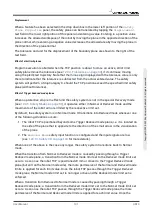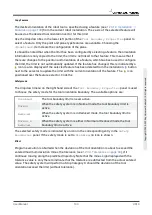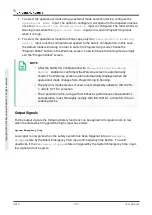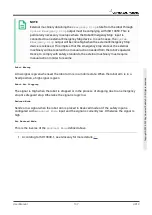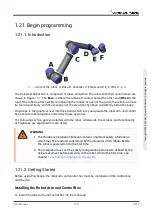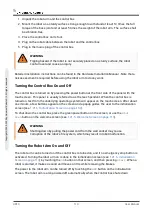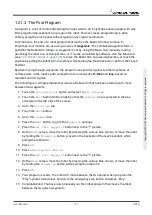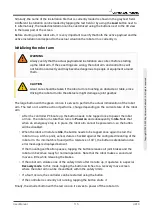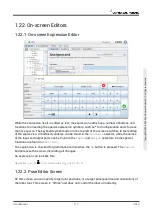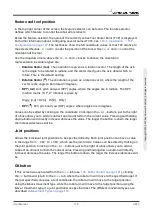
Reduced Mode
All safety limits have two modes in which they can be applied:
Normal
mode, which specifies the
default safety configuration, and
Reduced
mode (see
1.20.6. Safety Modes on page 91
for more
details). When this input safety function is selected, a low signal given to the inputs causes the
safety system to transition to
Reduced
mode. If necessary, the robot arm then decelerates to
satisfy the
Reduced
mode limit set. Should the robot arm still violate any of the
Reduced
mode
limits, it performs a Stop Category 0. The transition back to
Normal
mode happens in the same
manner. Note that safety planes can also cause a transition to
Reduced
mode (see
for more details).
Safeguard Reset
If
Safeguard Stop
is wired in the safety I/Os, then this input is used to ensure the Safeguard
Stopped state continues until a reset is triggered. The robot arm will not move when in Safeguard
Stopped state.
WARNING
By default, the
Safeguard Reset
function is configured for input pins 0 and 1.
Disabling it altogether implies that the robot arm ceases to be Safeguard Stopped
as soon as the
Safeguard Stop
input becomes high. In other words, without a
Safeguard Reset
, the
Safeguard Stop
inputs SI0 and SI1 (see the
Hardware Installation Manual ) fully determine whether the Safeguard Stopped
state is active or not.
Three-Position Enabling Device
and
Operational Mode
These allow for using a 3-position enabling device as an additional protective measure during
setup and programming of the robot. With the
Three-Position Enabling Device
input
configured, the robot is either in “running mode” or “programming mode”. An icon will appear in
the upper right corner displaying the current operational mode:
•
Running mode
: Robot can perform only pre-defined tasks. The Move tab and Freedrive
mode are unavailable.
•
Programming mode
: The restrictions present in
Running mode
are lifted. Whenever the
Three-Position Enabling Device
input is low, the robot is Safeguard Stopped and,
the speed slider is set at an initial value that corresponds to 250 mm/s in normal mode.
However, in reduced mode, the scaling remains the same as for normal mode, so the
speed slider does not always reach 250 mm/s; instead it can scale to a lower percentage
of the normal mode.
The speed slider can be incrementally increased to reach higher speed. The speed slider is
reset to the low value whenever the
Three-Position Enabling Device
input goes
from high to low.
There are two methods for configuring operational mode selection:
User Manual
105
UR10
C
o
p
yr
ig
h
t
©
2
0
0
9
–
2
0
2
0
b
y
U
n
iv
e
rs
a
l
R
o
b
o
ts
A
/S
.
A
ll
ri
g
h
ts
re
s
e
rv
e
d
.
Summary of Contents for UR10/CB3
Page 1: ...Universal Robots User Manual UR10 CB3 Original instructions en...
Page 28: ...UR10 20 User Manual Copyright 2009 2020 by Universal Robots A S All rights reserved...
Page 30: ...UR10 22 User Manual Copyright 2009 2020 by Universal Robots A S All rights reserved...
Page 36: ...UR10 28 User Manual Copyright 2009 2020 by Universal Robots A S All rights reserved...
Page 56: ...UR10 48 User Manual Copyright 2009 2020 by Universal Robots A S All rights reserved...
Page 62: ...UR10 54 User Manual Copyright 2009 2020 by Universal Robots A S All rights reserved...
Page 64: ...UR10 56 User Manual Copyright 2009 2020 by Universal Robots A S All rights reserved...
Page 72: ...China RoHS UR10 64 User Manual Copyright 2009 2020 by Universal Robots A S All rights reserved...
Page 73: ...KCC Safety User Manual 65 UR10 Copyright 2009 2020 by Universal Robots A S All rights reserved...
Page 92: ...UR10 84 User Manual Copyright 2009 2020 by Universal Robots A S All rights reserved...
Page 116: ...UR10 108 User Manual Copyright 2009 2020 by Universal Robots A S All rights reserved...
Page 124: ...UR10 116 User Manual Copyright 2009 2020 by Universal Robots A S All rights reserved...
Page 164: ...UR10 156 User Manual Copyright 2009 2020 by Universal Robots A S All rights reserved...
Page 214: ...UR10 206 User Manual Copyright 2009 2020 by Universal Robots A S All rights reserved...











